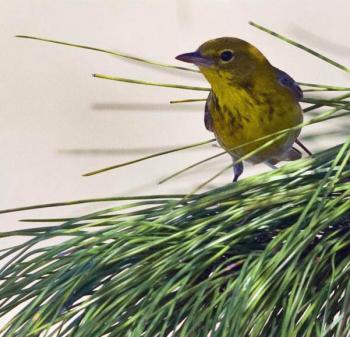Of Pines and the Warblers That Love Them
Warblers and other migrants are coming back quickly now. Every day seems to hold promise for some new arrival when we step out the door in the bright morning and listen for the bird songs and calls in the still, fresh air. Our most recent neighborhood arrival was a male blackburnian warbler, his vivid orange breast shining out like a beacon from the top of the cedar tree at the corner. For a week now we have enjoyed hearing the high pitched “wee-see-wee-see-wee-see” songs of zebra-striped black-and-white warblers and the distinctive “chuck” of yellow-rumped warblers as both species migrate through.
It has probably been a week or so since we also heard our first-of-the-year pine warblers here in Maine. Pine warblers have a trilling song that can be hard to differentiate from a number of other birds whose songs consist of trills. Chipping sparrows and dark-eyed juncos also have a trilling song (a series of the same short note repeated rapidly, making a rattling sound). Many people have trouble at first in distinguishing these different trilling songs; even experts can’t always tell some apart every time (some chipping sparrows can sound surprisingly like dark-eyed juncos, in particular). But pine warblers have a trilling song that is quite distinctive. Its song is often described as sounding very liquid, probably because there is not much space between each of the notes of the trill and because the individual notes are repeated at a slightly slower pace than in the chipping sparrow and junco.
Pine warblers are one of the earliest returning warblers here in Maine. They winter not so very far away, in the southeastern U.S., regularly as far north as West Virginia and Delaware with some birds often surviving during the coldest periods at suet feeders even as far north as right here in Maine. Most years, at least a few birds are seen or heard by March; certainly lots of them are back in April. This year, like most years, we first detect their presence by hearing their trills emanating from a pine grove. Unless we spend the time searching one of the singing birds out, we may not actually set eyes on one until sometime later when we happen to be birding near some pine trees. In recent years, we have had a pine warbler apparently on territory some blocks away from where we live such that we can hear singing from spring through early summer (the songs can often be heard from some distance away) but we never see the little guy.
As their name suggests, pine warblers are virtually restricted to pines except during migration when, like any warbler, they will find food wherever they can. But in summer (and to a great degree in winter as well) they spend all their time in pines. Even if you have trouble separating the different trilling bird species, a good rule of thumb is that if you hear the song coming from a pine, it is probably a pine warbler.
Interestingly, pine warbler populations have been moving northward over the last 50 years or so. In Ontario, breeding bird atlas projects documented what they termed “explosive” population growth between 1985 and 2005. In New Brunswick the breeding bird atlas project published in 1992 showed almost no pine warblers in the province; the updated atlas published in 2015 showed many pine warblers there. Here in Maine we know that pine warblers have expanded northward since our atlas was published in 1987 when they were largely confined to southernmost Maine. Now they are found regularly at least as far north as Baxter State Park. The newly launched second Maine Breeding Bird Atlas project that we wrote about in our column last week will provide the most up-to-date understanding of their current range limit and distribution.
Enjoy the “trill” of pine warblers this spring!
Jeffrey V. Wells, Ph.D., is a Fellow of the Cornell Lab of Ornithology. Dr. Wells is one of the nation's leading bird experts and conservation biologists and author of “Birder’s Conservation Handbook”. His grandfather, the late John Chase, was a columnist for the Boothbay Register for many years. Allison Childs Wells, formerly of the Cornell Lab of Ornithology, is a senior director at the Natural Resources Council of Maine, a nonprofit membership organization working statewide to protect the nature of Maine. Both are widely published natural history writers and are the authors of the book, “Maine’s Favorite Birds” and the recently published “Birds of Aruba, Bonaire, and Curaçao” from Cornell University Press.






























